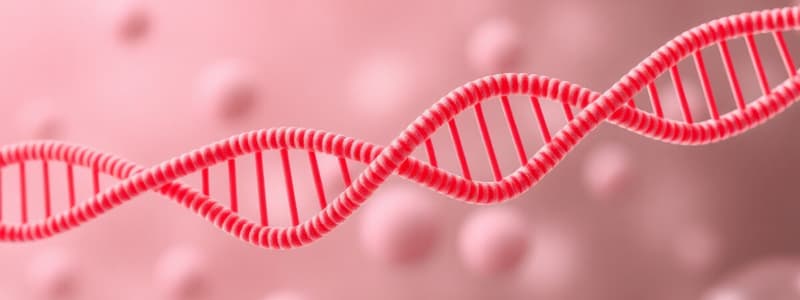Podcast
Questions and Answers
What function does a gene primarily serve?
What function does a gene primarily serve?
- To produce special functional RNA (correct)
- To code for structural proteins only
- To act as a spacer between proteins
- To exclusively code for DNA replication
Which strand of DNA is directly transcribed during the transcription process?
Which strand of DNA is directly transcribed during the transcription process?
- The sense strand
- The non-coding region
- The antisense strand (correct)
- The coding strand
What percentage of RNA is typically r-RNA in a cell?
What percentage of RNA is typically r-RNA in a cell?
- 30%
- 10%
- 80% (correct)
- 50%
What is a primary transcript?
What is a primary transcript?
What process involves removing introns and stitching together exons in RNA?
What process involves removing introns and stitching together exons in RNA?
Which type of RNA is characterized by the presence of a CCA sequence at its 3' end?
Which type of RNA is characterized by the presence of a CCA sequence at its 3' end?
What modification is made to m-RNA at its 5' end?
What modification is made to m-RNA at its 5' end?
Which of the following r-RNA types is found in prokaryotes?
Which of the following r-RNA types is found in prokaryotes?
What happens during terminal addition to m-RNA?
What happens during terminal addition to m-RNA?
Which of these RNA types is present only in eukaryotes?
Which of these RNA types is present only in eukaryotes?
Which unit of the prokaryotic RNA polymerase primarily stabilizes the shape of the core enzyme?
Which unit of the prokaryotic RNA polymerase primarily stabilizes the shape of the core enzyme?
What is the significance of the σ factor in the formation of the RNA holoenzyme?
What is the significance of the σ factor in the formation of the RNA holoenzyme?
Where is the promoter box typically located in relation to the transcribable portion of a gene?
Where is the promoter box typically located in relation to the transcribable portion of a gene?
What are the subunits that perform the catalytic function in prokaryotic RNA polymerase primarily responsible for?
What are the subunits that perform the catalytic function in prokaryotic RNA polymerase primarily responsible for?
What designation is given to the first nucleotide that is transcribed after the RNA polymerase begins to function?
What designation is given to the first nucleotide that is transcribed after the RNA polymerase begins to function?
Which sequence is commonly found in the Pribnow box of a prokaryotic promoter?
Which sequence is commonly found in the Pribnow box of a prokaryotic promoter?
How are the nucleotides prior to the +1 designation numbered?
How are the nucleotides prior to the +1 designation numbered?
What is the core enzyme of prokaryotic RNA polymerase composed of?
What is the core enzyme of prokaryotic RNA polymerase composed of?
What is a characteristic of the holoenzyme once it has attached to the promoter box?
What is a characteristic of the holoenzyme once it has attached to the promoter box?
Which of the following statements is true regarding RNAP's entry into the promoter region?
Which of the following statements is true regarding RNAP's entry into the promoter region?
Flashcards
What is a gene?
What is a gene?
A specific sequence of nucleotides in DNA that codes for a functional RNA molecule.
Spacer DNA
Spacer DNA
Regions of DNA that don't code for RNA and act as spacers between genes.
Transcription
Transcription
The process of copying genetic information from DNA to RNA.
Antisense strand
Antisense strand
Signup and view all the flashcards
Sense strand
Sense strand
Signup and view all the flashcards
Post-transcriptional modifications
Post-transcriptional modifications
Signup and view all the flashcards
Primary transcript
Primary transcript
Signup and view all the flashcards
r-RNA
r-RNA
Signup and view all the flashcards
m-RNA
m-RNA
Signup and view all the flashcards
t-RNA
t-RNA
Signup and view all the flashcards
Promoter Box
Promoter Box
Signup and view all the flashcards
Sigma Factor (σ)
Sigma Factor (σ)
Signup and view all the flashcards
β and β' subunits
β and β' subunits
Signup and view all the flashcards
ω (Omega) subunit
ω (Omega) subunit
Signup and view all the flashcards
RNA Holoenzyme
RNA Holoenzyme
Signup and view all the flashcards
-35 sequence
-35 sequence
Signup and view all the flashcards
Pribnow Box
Pribnow Box
Signup and view all the flashcards
Template strand
Template strand
Signup and view all the flashcards
+1 nucleotide
+1 nucleotide
Signup and view all the flashcards
Study Notes
Transcription
- A gene is a specific nucleotide sequence in DNA, responsible for producing functional RNA
- DNA contains sequences between genes that don't code for RNA, called spacer DNA
- During transcription, only one DNA strand is transcribed, acting as a template. This is called the antisense strand
- The resulting RNA is complementary to the antisense strand (and identical to the other DNA strand). This other strand is the sense strand
- RNA polymerase synthesizes RNA
Types of RNA
- There are four major types of RNA
- rRNA (ribosomal RNA): most abundant, 80%
- mRNA (messenger RNA): most massive
- tRNA (transfer RNA): smallest
- snRNA (small nuclear RNA): found only in eukaryotes, small
- When RNA is first produced during transcription, it's called the primary transcript
- Primary transcripts undergo post-transcriptional modifications
- Terminal trimming
- Terminal addition
- Internal segment removal (removal of introns)
- Splicing (joining of exons)
- Base modifications (mostly in mRNA). Some bases can be modified
Prokaryotic rRNA Types
- Prokaryotic cells have three types of rRNA: 5S, 16S, and 23S (Svedberg units)
Eukaryotic rRNA Types
- Eukaryotic cells have four types of rRNA: 5S, 5.8S, 18S, and 28S
tRNA Structure
- Every tRNA has a CCA sequence on the 3' end
- This sequence attaches and carries amino acids
mRNA Modifications
- Examples of terminal additions to primary mRNA transcripts include:
- Guanine capping (methylated guanine triphosphate added to 5' end)
- Poly-A tail (adenine nucleotides added to 3' end)
Transcription in Prokaryotic Genes
- Prokaryotic RNA polymerase (RNAP) is made of multiple subunits. The core enzyme consists of 5 subunits (2 α, β, β', and ω). The complete holoenzyme includes a 6th subunit (σ factor)
- The sigma factor (σ subunit) is crucial for recognizing a gene's promoter region and attaching the holoenzyme to the promoter. After binding, the sigma factor detaches and moves downstream, unzipping the DNA. The ω subunit plays a structural role.
- RNA nucleotides stabilize RNAP on the DNA after sigma factor dissociates
Transcription Initiation
-
RNAP holoenzyme attaches to a gene at a specific place called a promoter box which is typically located upstream from the gene (on the 5' end)
-
The promoter box commonly has two regions:
- −35 region (sequence: TTGACA)
- −10 region (Pribnow box; sequence: TATAAT).
-
RNAP holoenzyme can bind either or both promoter regions
-
The first transcribed nucleotide is assigned the +1 designation. The nucleotides before +1 are given negative numbers.
Promoter Box Location & Role
- The location of the promoter box is conventionally determined by the sense strand, not the template strand.
- Modifications in the promoter box sequence can affect the rate of transcription
Studying That Suits You
Use AI to generate personalized quizzes and flashcards to suit your learning preferences.
Related Documents
Description
This quiz covers the process of transcription in DNA and the different types of RNA involved. Learn about the roles of rRNA, mRNA, tRNA, and snRNA, as well as the modifications that primary transcripts undergo after transcription. Test your knowledge on this essential biological process.




